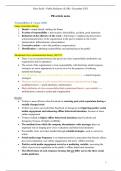Summary
Summary of all the articles for Public Relations (Msc Communication Science, VU))
- Module
- Institution
This summary discusses all the articles from the electronic reader of the course Public Relations (PR) in the Communication Science master at the VU, required for the exam. It describes the research questions, hypotheses and results of each article. Good luck!
[Show more]












